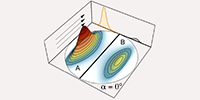Abstract
Classical rate theories often fail in cases where the observable(s) or order parameter(s) used is a poor reaction coordinate or the observed signal is deteriorated by noise, such that no clear separation between reactants and products is possible. Here, we present a general spectral two-state rate theory for ergodic dynamical systems in thermal equilibrium that explicitly takes into account how the system is observed. The theory allows the systematic estimation errors made by standard rate theories to be understood and quantified. We also elucidate the connection of spectral rate theory with the popular Markov state modeling approach for molecular simulation studies. An optimal rate estimator is formulated that gives robust and unbiased results even for poor reaction coordinates and can be applied to both computer simulations and single-molecule experiments. No definition of a dividing surface is required. Another result of the theory is a model-free definition of the reaction coordinate quality. The reaction coordinate quality can be bounded from below by the directly computable observation quality, thus providing a measure allowing the reaction coordinate quality to be optimized by tuning the experimental setup. Additionally, the respective partial probability distributions can be obtained for the reactant and product states along the observed order parameter, even when these strongly overlap. The effects of both filtering (averaging) and uncorrelated noise are also examined. The approach is demonstrated on numerical examples and experimental single-molecule force-probe data of the p5ab RNA hairpin and the apo-myoglobin protein at low , focusing here on the case of two-state kinetics.
- Received 18 July 2012
DOI:https://doi.org/10.1103/PhysRevX.4.011020
This article is available under the terms of the Creative Commons Attribution 3.0 License. Further distribution of this work must maintain attribution to the author(s) and the published article’s title, journal citation, and DOI.
Published by the American Physical Society
Popular Summary
How is the rate constant of a chemical process defined, and how can we measure it? These are elementary questions in chemical physics as old as the discipline itself. The traditional paradigm is the so-called classical transition-state theory. It evokes the picture of a barrier transition state clearly separating the initial and the final states and the system jumping back and forth across the barrier aided by thermal fluctuations. Just as fundamentally, it assumes that a “reaction coordinate” that unambiguously represents this state landscape and the system’s dynamics directly corresponds to an experimental observable. It then determines the rate (constant) by counting the number of barrier crossings in a given time of observation.
But contemporary single-molecule experiments of extraordinary precision have revealed fundamental shortcomings of the classical theory and many other theories and rate estimators derived from it. The classical theory, in its most original form, drastically overestimates the rate of many single-molecule processes, and the derived theories designed to address the overcounting issue work well only in situations where the assumption of the direct correspondence between the experimental observable(s) and the reaction coordinate holds. In this paper, we provide an answer to these shortcomings by developing a “spectral rate theory,” whose effectiveness is demonstrated on numerical examples and experimental single-molecule force-probe data on an RNA hairpin and a myoglobin protein molecule.
Our theory allows the quality of an experimental observable at hand as a reaction coordinate and, in turn, the need to repeat the experiment with other accessible observables, to be systematically estimated. In addition, our theory also provides a new optimal rate estimator that gives robust and unbiased results even when poor reaction coordinates are used, even in the case when the initial and final states correspond to a population of many long-living states and show no clear separation in the presentation by the available experimental observable(s).
Our work represents a significant advance on the solution to one of the most fundamental but outstanding problems in chemical and biological physics. It should lead to experimental applications and further theoretical development that will make the approach more accurate, powerful, and more broadly useful.



